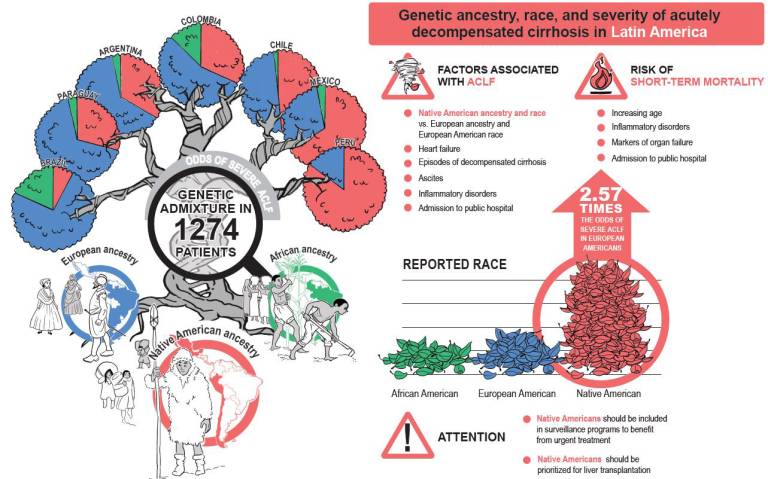Latin Americans with greater Native American ancestry more susceptible to liver failure
15 June 2023
Differences in the percentage of Native American ancestry in Latin American people are linked with the chances of them developing severe liver failure and associated high risk of short-term mortality, a study co-authored by UCL has found.

The ACLARA study, published in Gastroenterology, is the first of its kind to indicate that ancestry and race may determine the outcome of advanced liver disease (decompensated cirrhosis) in patients.
The large prospective observational study, co-authored by Professor Rajiv Jalan (UCL Division of Medicine), found a high prevalence of severe acute-on-chronic liver failure (ACLF) and high risk of 28-day mortality in liver disease patients that had a greater percentage of Native American ancestry and reported race than those of European and African descent.
The study also found socio-economic factors are associated with the probability of developing ACLF in the Latin American population, with those able to afford private treatment less likely to develop the condition.
Co-author Professor Rajiv Jalan (UCL Division of Medicine) said: “The data generated in the ACLARA study provides the first indication for the important association of Native American race and ancestry in the development of liver failure and its associated mortality.
“It appears that the mechanism of this susceptibility is markedly higher systemic inflammation, which is a central operative mechanism of liver failure. These data have implications for initiating more intense screening programmes for liver disease in this population and further research to understand their susceptibility to other diseases and the mechanisms underlying increased inflammation.”
According to a recent study (Global burden of liver disease: 2023 update), liver disease accounts for more than two million deaths annually (cirrhosis, viral hepatitis, and liver cancer) and for 4% of all deaths worldwide (one out of every 25 deaths). One in three liver-related deaths occurs among females.
Liver cirrhosis mortality in Mexico was the highest in Latin America in 2010, with a mortality rate of 38.3 per 100,000.
A previous large study in Europe, CANONIC, identified ACLF as a distinct syndrome that develops in 30% of patients with acute decompensation of cirrhosis.
Clinical features of ACLF are failure of multiple organs including the liver, kidneys, brain, heart, lungs, blood clotting and a high risk of infection. Recovery from ACLF, either using intensive care or liver transplantation, can normalise the function of these organs.

To gain further insight into the relationship between genetic ancestry, race and the probability of developing ACLF and associated risk of short-term mortality, researchers studied hospitalised cirrhosis patients from seven countries across Latin America.
Latin American populations have varying percentages of genetic variants of Native American, African and European ancestry, as a result of a long history of modern human migrations and admixture (genetic exchange among people of different descent).
The ACLARA study was carried out in 1,274 patients non-electively hospitalized for acute decompensation of cirrhosis in 44 university hospitals, from 27 cities across Argentina, Brazil, Chile, Colombia, Mexico, Paraguay, and Peru.
The study group reported ACLF of any grade in 31.0% of patients at enrolment. Of these, 54.2% presented with ACLF grade 1, 24.9% had ACLF grade 2, and 20.9% had ACLF grade 3 (meaning three or more organ failures).
In addition to genetic ancestry, race was assessed by the physician at hospital admission. Researchers assessed genetic ancestry with the use of genetic markers of ancestry, and not by parental indicators of ancestry.
Overall, patients admitted to hospital with ACLF showed a higher percentage of Native American ancestry and a lower percentage of European ancestry compared to patients with acute decompensation of cirrhosis without ACLF (22.6% and 53.4% vs. 12.9% and 59.6%, respectively).
The percentage of African ancestry was low in both hospitalised patients with ACLF and patients without ACLF among participating countries (6.9% vs. 6.5%).
First author Alberto Farias (Principal Investigator, Hospital das Clínicas, University of São Paulo School of Medicine, Brazil) said: “Investigating ACLF in other cohorts may strengthen the understanding of other upstream factors on disease expression. The Latin American region, with different racial and genetic ancestries, is a unique landscape for in-depth assessment of such factors.”
ACLARA was funded by the European Foundation for the Study of Chronic Liver Failure (EF CLIF), of which Professor Jalan is Scientific Director.
Links
- Research paper in Gastroenterology
- Professor Rajiv Jalan's academic profile
- UCL Division of Medicine
- UCL Faculty of Medical Sciences
- School of Life & Medical Sciences
- EF CLIF
Image
- Credit: Mohammed Haneefa Nizamudeen / iStock
- Infographic: Credit EF CLIF. CC BY NC ND license.
Media contact
Sophie Vinter
Tel: +44 (0)20 3108 7787
Email: s.vinter [at] ucl.ac.uk
 Close
Close

